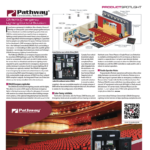Each year, mobile stages made by Stageline, a staging manufacturer based in L’Assomption, Quebec, get used at 15,000 events in 45 countries around the world. That number is likely to increase this year as Stageline rolls out its SAM750 — the largest hydraulic mobile stage in the world. First used at the 2013 Osheaga festival in Montreal last August, the SAM750 made its U.S. debut at Electric Daisy Carnival (EDC) New York over Memorial Day weekend.
The massive stage measures 70 feet wide by 50 feet deep, with a trim height of 52 feet above the deck, which sits 6 to 7 feet off the ground. Extending beyond the stage performance area are covered stage wings, which measure 28 feet wide by 48 feet deep, and a backstage loading dock measuring 130 feet wide by 12 feet deep.
Setup
You won’t, of course, ever see a 130-foot-wide behemoth rolling down the highway. The stage arrives in the form of six standard size and weight tractor-trailers. When built, five out of the six tractor-trailers themselves are actually an integral part to the erected stage’s construction. The SAM750 comes with four Stageline technicians to lead the setup. In addition, it requires 12 local stagehands, two forklifts (for two 8-hour days) and a 35-ton crane (for the first day).
On Day One, it all starts with Trailer 1, which contains the floor. Once the trailer is in place, all of the support structure unfolds from the trailer body, and the hinged decking slides out like an accordion onto the supports. Trailer 2 is next in line and contains the roof. It lines up directly behind the first trailer and hydraulically rises to the stage floor height. Then, the top portion is transferred off the trailer onto the stage via a rail system. Once in place, the trailer frame and wheels can be hauled away. The downstage and upstage roof trusses unfold and then the perpendicular trusses expand in an accordion fashion.
Trailers 3, 4, 5 and 6 are 53-foot flatbeds that transport ancillary equipment. Trailers 3 and 4 carry the telescoping hydraulic columns and baseplate footings. The crane is needed to offload these trailers and set the components in place. Trailers 5 and 6 are responsible for covered wings, extension platforms, wind walls, and stage accessories.
At the end of Day One, the floor including extension platforms for wings, roof, and columns are all installed. At the beginning of Day Two, the crew raises the roof just enough to allow for the rigging of chain motors. With the use of aluminum spreader bars, no bridling is required. After the rigging is complete, the roof will rise to its final trim height. All columns will be secured with pins, and the loading dock area gets built. Three of the four trailers are part of the backstage loading dock. One hydraulically tilts to serve as a ramp between standard truck height and the backstage loading dock area (as seen in Photo 2). Now that the stage is complete, it is time for the production load-in to begin.
Safety Features
SAM750 comes with numerous safety sensors and redundancy systems. First and foremost, the stage was designed and engineered in-house at Stageline according to the International Building Code (IBC) for Temporary Structures and sealed in all provinces of Canada. The design then went to a third party engineering firm in the U.S., which performed a peer review and sealed it for all 50 states. The overall safety design factor is 2. (Note: To some, this number may seem low, especially compared with consumer hardware like eyebolts and shackles, but for an engineered structure, it is both typical and acceptable. It means, for example, that although the roof is rated for a maximum allowable load of 150,000 pounds of gear, it is engineered to support 300,000 pounds of gear.)
Each of the four columns contains pressure sensors, which provide roof-loading information. Hydraulics are used to erect the stage and roof, but then all connections are secured with pins or bolts, depending on the type of connection. The hydraulic pressure remains in the lines as a backup if any pin or bolt should fail. The hydraulic system contains block valves throughout, which protect the system if any one line is cut or should break. Each column base plate acts a drip pan in case of any oil leaks or drips. This is a preventative measure to eliminate oil spills onto the ground. All hydraulics are controlled via a wireless remote, but have manual controls in the event of a failure. On the very top of the roof is an anemometer to measure current wind speed and direction.
Stageline takes wind and weather a step further by contracting a private weather firm to provide meteorological forecasting based on the location of each event. The firm provides daily updates of the weather and forecast and will contact the lead technician if any threats are present. A “threat” is defined by a threshold level set by Stageline. This way, the crew can proactively respond to the threat before the storm arrives.
Anytime the stage is in use, two Stageline technicians are on duty. Although the structure is rated for 60 m.p.h. winds with walls installed (and 90 m.p.h. without), Stageline’s operating procedure requires the walls and speaker scrims to be lowered at 40 m.p.h. This process can be performed in less than three minutes.
At a Glance
The World’s Largest Mobile Stage
Stageline’s SAM750 is the world’s largest mobile stage. Although the product is not currently for sale, it is available for rental in North America from Stageline’s rental division, Mobile Stage Rentals (MSR). Delivered and assembled using six standard size and weight tractor trailers, the mobile stage is engineered with safety in mind and approved for use in Canada and all 50 U.S. states. It promises to be easier and less expensive to assemble than traditional scaffold or truss style stages relying on numerous ballasts and guy wires for support.
Stageline SAM750 Features:
- 150,000 lb. Roof Rigging Capacity
- 25,000 lb. Rigging Capacity per side for Audio
- 90 m.p.h. Wind Resistance (wind walls removed)
- 60 m.p.h. Wind Resistance (wind walls attached)
- Self-Supported Structure
- No need to bridle
- 52’ Trim Height
- Hydraulic Stage
- Mobile, using six tractor trailers
- Fully Engineered
- Numerous safety and redundant features


